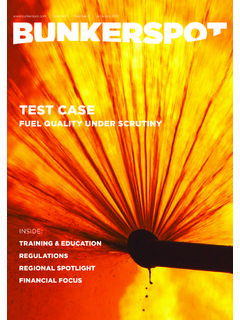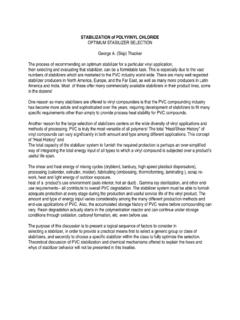Transcription of ThaT sinking feeling - Drew Marine
1 Volume 10 Number 5 October/November 2013. that sinking feeling Can shipping take the pressure? Inside: Credit insurance Shipping finance Fuel quality Regional focus fuel quality Close analysis Albert Leyson of Drew Marine flags up some of the quality issues that can occur in the use of distillates S Bunker purchasers often assume trict regulations are planned for the near future by the International Maritime Organization (IMO) and that distillate fuel oil grades, with other authorities that require alternative fuel systems or exhaust gas cleaning systems. the most common being DMA. The most highly promoted and anticipated alternative fuel by major Classification grade, are all cr me de la cr me in societies and specific Marine segments is terms of overall fuel oil quality'. undoubtedly liquefied natural gas (LNG). Capable of meeting the most stringent exhaust emission limits for sulphur oxides (SOx) and nitrous oxides (NOx) alike, LNG common fuel alternative distillate fuel distillate fuel oil bunkers, merely for MARPOL.
2 Has hit the mainstream as prominent ship oil. Similarly, early adopters of dual-fuel 73/78 Annex VI Regulation 18 compliance, operators have requested that some of LNG-ready engines must also effectively and never consider the need to actually their recent newbuild orders be delivered manage the pilot fuel, typically distillate fuel oil, obtain and analyse a separate distillate LNG-ready', meaning they can easily be required for LNG ignition, and for when natural fuel oil sample. In fact, laboratory statistics retrofitted to use LNG in the future. gas or residual fuel oil is unable to be used. suggest that only 20%-30% of distillate fuel Even though the IMO will likely postpone For vessels that have opted not to oil samples routinely get analysed. Even the entry into force of the MARPOL 73/78 equip their exhaust stack with an exhaust more alarming is that a majority of vessels Annex VI Tier III NOx emissions limit for gas cleaning system ( scrubber), fuel that predominantly use distillate fuel oil five years (originally effective in 2016, now switchover to distillate fuel oil will be the default actually have never tested for its quality extended to 2021), the US Environmental action for most ships when they are required parameters.
3 So the question remains, how Protection Agency (EPA) still requires to emit less emissions. Fuel switchover would can you ensure that you got what you paid US-flagged vessels to be compliant from be required prior to entering a reduced for? With an average price premium between January 2016. In preparation, some engine exhaust emission zone, whether it is required 50%-60% of that of RMx 380 grade fuel oil, manufacturers have recently launched for vessels operating in port as required by the it is important to identify some of the quality- dual-fuelled engines and LNG conversion European Union (EU), or in specific regional related problems pertaining to distillate fuel oil. packages in anticipation of the future demand areas as defined by the IMO's ECA zones and Considering the importance of LNG. for fuel flexibility. Finally, to manage fuel availa- the California Air Resources Board (CARB), for ignition, and more importantly given that bility as a result of an ever-increasing fleet of example.
4 Distillate fuel oil that is used mainly for it is the most viable alternative to burning LNG-powered vessels, more LNG bunkering this reason would likely be stored for extended high sulphur residual fuel oil distillate ports will be coming online, including the periods of time; hence, the new distillate fuel fuel oil should meet the requirements one slated to open in February 2014 at oil requirement for oxidation stability is formed, as specified in ISO 8217:2012 Table 1. Port Fourchon, Louisiana. Propelled by the as stipulated by the most recent edition of There are more critical parameters growing US gas market, the new LNG bunker the ISO 8217:2012 Marine fuel specification, that revolve around sulphur content and its terminal will cater to LNG-equipped offshore limiting its value to 25 g/m 3 maximum. associated parameters, viscosity, and lubricity. workboats, and other vessels operating in Although ISO 8217:2012 defines a First and foremost, the arbitrary maximum the Gulf of Mexico region, within the North common quality standard in which Marine fuel values given for sulphur bear no reflection of American Emission Control Area (ECA).
5 Oil is commercially bought and sold, bunker actual Marine distillate fuel oil sulphur content. Regardless of the types of vessels and/ purchasers often assume that distillate fuel oil Since 2011, the percentage of distillate fuel oil or trades that eventually embrace LNG as grades, with the most common being DMA samples analysed with sulphur content less their primary source of energy, ship operators grade, are all cr me de la cr me in terms of than mass % has been steadily increasing utilising conventional diesel engines often overall fuel oil quality. As such, many ship to over 80% in the year-to-date. One possible overlook management of the other, more operators typically obtain just one sample of explanation for the dramatically increased Bunkerspot October/November 2013 65. fuel quality percentage every year is the carryover of loaded with 200 g mass, against a test disk cost. As such, in bunker ports where demand On-Highway or On-Road Ultra-Low Sulphur that is completely submerged in a heated 2 exceeds supply, unscrupulous Marine fuel Diesel (ULSD) stock into the Marine bunker ml fuel sample, with a 1 mm stroke, and at suppliers may create low sulphur fuel oil laden market in order to meet the increased demand.
6 A frequency of 50 Hz for 75 minutes. After with bio-derived materials, inorganic acids, or this time-intensive test, the ball is cleaned, used lubricating oils (ULO). Since all have little and the major and minor dimensions of the to no sulphur content, they make excellent oil Sulphur Percentage of Distillate Fuel Oil wear scar are measured under 100x magnifi- cutter stock. The presence of certain acids or %m/m 2011 2012 2013(YTD). cation and averaged. The resulting average oil soluble metals from biodiesel components is given as the wear scar diameter at the and used lube oil has been known to cause > tested temperature, in this case at 60 C. internal diesel injector deposits (IDID). Note, while the distillate fuel oil's viscosity IDID disrupts the injection process and Sulphur Percentage of Distillate Fuel Oil effects on lubricity are not totally eliminated, consequently affects the combustion process, %m/m 2011 2012 2013(YTD) they are minimised with this test method.
7 Thus potentially causing any number of negative According to the most current ISO 8217 consequences to injection equipment, - revision, lubricity is required to be tested for engine internals, and exhaust system. The distillate fuel oils with sulphur content below presence of these internal deposits can Courtesy: Oiltest Marine Services mass % (500 mg/kg). Statistics clearly inhibit or completely prevent the motion of show that , at time of writing, nearly half of key internal fuel injection parts, which can Given the percentage of distillate fuel oil the distillate fuel oil samples would in fact disrupt the pressure, timing and/or amount of samples that have record high level sulphur require lubricity to be analysed. One major fuel delivered to each cylinder. This disruption values, it becomes essential to evaluate the Marine engine manufacturer goes further causes combustion-related problems that oil's boundary layer lubrication properties and and states in its Low Sulphur Guideline: reduce overall emission and available power, the associated risk concerning insufficient Documented experience about fuels with and increase fuel consumption.
8 In extreme boundary layer lubrication. Evaluated lower sulphur content than mass cases, complete engine failure can occur. separately, the distillate fuel oil's minimum % (100 mg/kg) is not available. However, Drew Marine first offered its lubricity viscosity and/or lubricity are typically specified in extreme cases a lubricity additive can additive, AMERGY XLS, to the Marine market by diesel engine and boiler manufacturers in be added to very low sulphur fuel ' more than a year prior to the entry into force order to assess the relative effectiveness Gathering documented experience, such of the Baltic Sea ECA in 2006, when fuel of the oil's ability to prevent metal-to-metal as fuel test reports, remains a challenge sulphur content was capped to mass wear in fuel injection and fuel pump internals. since distillate fuel oil samples are seldom %. In addition to imparting lubricity, the active The distillate fuel oil's minimum viscosity submitted for analysis.
9 Furthermore, the components in AMERGY XLS reduced the is an indicator of the fluid's ability to maintain additional cost incurred for carrying out likelihood of incompatibility faced during adequate film thickness. In cases where the time-intensive HFRR lubricity testing fuel switchover, improved storage stability, the minimum viscosity is not met, there is a may sound unappealing. While Drew and helped minimise the formation of likelihood the oil film can fail and leak, resulting Marine offers these analytical services in carbonaceous deposits on injector tips. With in equipment loss of pressure, cavitation, or partnership with Oiltest Marine Services in a further reduction in fuel sulphur content worst-case scenario, seizure. To prevent order to prevent the occurrence of extreme due in 2015, limited to mass %, Drew this from occurring, diesel engine and boiler cases, it may prove more cost-effective to Marine 's most recent fuel additive, AMERGY.
10 Manufacturers routinely instruct a chiller or instead treat the fuel with a lubricity additive, ULS-D, was designed specifically to address cooler be installed and used to adequately since the percentage of distillate fuel oil IDID problems, such as fouling of critical raise the oil viscosity to the minimum level. with very low sulphur continues to increase. fuel slide valves. The additive can effectively Since the parameter's introduction in Another fuel quality related problem remove any deposit that has formed and can the ISO 8217:2010 revision, the boundary associated with low sulphur fuel oil involves prevent any new fouling from accumulating. layer property of lubricity provides the the inclusion of substances, such as fatty With the potential to significantly extend the distillate fuel oil's ability to prevent wear. The acid methyl ester (FAME), inorganic acid, used service life of fuel injection parts, AMERGY. standard test method for lubricity is done lubricating oil (ULO), or any added substance ULS-D ensures that the distillate fuel oil with a High-Frequency Reciprocating Rig or chemical waste that would jeopardise the used in the next generation and duel-fuelled (HFRR) that evaluates the ability of a fluid to safety of the ship, or adversely affect the diesel engines remains trouble free.








